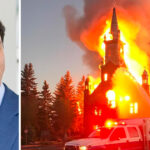By Jonathon Van Maren
Ever since Margaret Atwood’s novel A Handmaid’s Tale has been turned into a much-acclaimed TV miniseries depicting a dystopia run by “Christians” who obviously know nothing about Christianity (which doesn’t get noticed, because TV critics know nothing about Christianity, either), Canadian literature has suddenly been a far hotter topic than usual. Atwood herself has become something of a liberal icon, with hilarious comparisons to the fantasy world created by Atwood and Trump’s America being obliviously drawn in the editorial pages of nearly every mainstream newspaper—comparisons solemnly approved of by Atwood herself.
Because of this sudden attention, there seems to be a rather pervasive idea—heavily promoted by those paid to discuss literature on the “book shows” of the CBC and in the pages of snooty Canadian magazines—that Canadian literature affirms and supports the liberal consensus that all liberals assume prevails in a nation so enlightened as Canada. That idea, however, is not supported by a closer look at Canadian stories and Canadian storytellers. A more objective examination, in fact, reveals that despite the emergence of some progressive ideas, Canadian literature—with notable exceptions—seems to have a largely conservative undercurrent.
This isn’t true for all of my childhood favorites, of course. Growing older always brings discoveries about some of your heroes that you rather wish you hadn’t stumbled across. I was disappointed to find out while researching an entirely different topic that Pierre Berton, the masterful historian with the unmatched ability to make Canadian history come alive, was actually an honorary director for the Canadian Association for the Repeal of Abortion Laws. Berton was a well-known atheist—he had rhetorical brawls with the incendiary conservative publisher Ted Byfield on television and wrote a book critiquing the then-conservative Anglican Church titled The Comfortable Pew, which was responded to by Byfield, who wrote Just Think, Mr. Berton (A Little Harder) in a manner reminiscent of the book-length duels of Hilaire Belloc and H.G. Wells over the theories contained in The Outline of History.
But despite Berton’s at times whiny atheism and dedicated abortion activism, even Byfield still speaks of him admiringly. “The man gave us a history,” he said to me once. And so he did—from documentaries on the building of the Canadian Pacific Railway that aired in every high school in the country to the enormous hardcover book The Klondike that sat on my grandparent’s coffee table, Berton wrested the titans of the Gold Rush and the wilderness and the wars from dusty and droning historians and breathed life into them until suddenly you felt that being a Canadian meant something, after all.
And then there was Farley Mowat, that great Canadian storyteller every child was familiar with. I found battered copies of Owls in the Family—which my Second Grade class later had to read together–The Black Joke, and Lost in the Barrens on my dad’s office bookshelf, worn by readings and re-readings. After that came The Boat That Wouldn’t Float, Never Cry Wolf, and my all-time favorite, The Dog That Wouldn’t Be, which one of my friends in the Canadian Navy refers to as one of the “most culturally conservative books ever written in Canada.”
Mowat was a master, from describing his childhood on the Canadian prairies to capturing the desolate, beautiful wilderness of the Great White North. He was not a conservative by any stretch of the imagination—he once told Michael Harris that “Stephen Harper is probably the most dangerous human being ever elevated to power in Canada”—but his conservationism was borne out through beautiful books that captured traditional ways of life and highlighted the cost of losing such a magnificent natural heritage. As someone who spent scores of childhood hours hiding in a culvert catching frogs, poking through muskrat dens in the creek, and hiding in the grass near a coyote den to see if anything would surface, Mowat’s stories of wilderness and wild pets resonated with me. Mowat might have considered himself a radical, but at his very core, he was a traditionalist—and defences of tradition poured from his pen.
If there was any lyrical genius who could sing (and sound) like Berton and Mowat could write, it was Stan Rogers, the folk giant who penned the lines of Northwest Passage, which Stephen Harper once called the “unofficial Canadian anthem”:
Westward from the Davis Strait ’tis there ’twas said to lie
The sea route to the Orient for which so many died;
Seeking gold and glory, leaving weathered, broken bones
And a long-forgotten lonely cairn of stones.
Ah, for just one time I would take the Northwest Passage
To find the hand of Franklin reaching for the Beaufort Sea;
Tracing one warm line through a land so wide and savage
And make a Northwest Passage to the sea.
Stan Rogers’ travels across Canada with his brother Garnet and a few other band members in the 1970s and early ‘80s would eventually redefine Canadian folk music with magnificent stories of tankers on the Canadian Great Lakes, life in the Maritimes (where his family originated), epic gales, and ugly shipwrecks. His message was often a fundamentally conservative one—the most explicit example of this being his song The Idiot, in which he memorialized the Maritimes exodus to the prairies in search of work:
I often take these night shift walks
When the foreman’s not around
I turn my back on the cooling stacks
And make for open ground
Far out beyond the tank-farm fence
Where the gas flare makes no sound
I forget the stink and I always think
Back to that Eastern town
I remember back six years ago
This western life I chose
And every day the news would say
Some factory’s going to close
Well, I could have stayed to take the dole
But I’m not one of those.
I take nothing free, and that makes me,
An idiot, I suppose…
So bid farewell to the Eastern town
You never more will see.
There’s self-respect and a steady check
In this refinery.
You will miss the green and the woods and streams
And the dust will fill your nose.
But you’ll be free, and just like me,
An idiot, I suppose.
Stan Rogers was on the cusp of recognition when death came for him early—at the age of 33 on June 2, 1983. Stan was one of twenty-three passengers that perished on Air Canada Flight 797 after a fire on board the plane forced a landing at the Greater Cincinnati Airport, en-route from Dallas—where Stan had been performing—back home to Canada. As the plane was being evacuated, a flash fire erupted. Rogers died of smoke inhalation.
A legend has sprung up surrounding Stan’s last moments. His biographer, Chris Gudgeon, wrote that a giant, bald-headed man had been working feverishly in the smoke, carrying women to the door of the plane to push them into clean fresh air and safety. Blogger Amber Frost, too, relayed the rumors: “He used his last moments to guide other passengers to safety with his booming voice. I’ve heard more than one Canuck proudly declare that for all Rogers’ odes to Canada, he was never more Canadian than his final words: ‘Let me help you.’”
The legends were probably just that: Legends. Some time ago, I met with Stan’s brother, Garnet Rogers, at a Tim Horton’s near his home in Brantford, Ontario. I asked Garnet if he thought the rumors were true, and he shook his head. “I always tell people not to tell those stories, because Stan would have hated—hated—being give credit for anything he didn’t do.” But much of what people now believe about Stan Rogers is legend, with Garnet recently trying to correct the record with an enormous memoir of his ten years on the road with Stan. “Don’t let people tell you that they were big fans of Stan back in the day,” he growled to me with a scoff. “The last concert we played in Canada—in Vancouver—only three people showed up.” The passing of years, however, has been kind to Stan—some of his songs have even entered high school curriculums as timeless Canadian poetry.
Not all Canadian troubadours have had to wait so long for recognition. Leonard Cohen, the raspy poet who wrote Flowers for Hitler, passed away last year to mourning and acclaim from nearly every quarter. As I wrote just a few weeks before his death, however, Cohen did attract some suspicion from the Left, some of whom suspected that in spite of his revolutionary lines he was perhaps not fully committed to secular sacraments like legal abortion. Those narrow-eyed critics might have had a point. His work shows a clear and progressively growing disillusionment with our throwaway culture’s crude approach to everything good and beautiful, and his words often smolder with contempt. In “Stories from the Street,” he described the bankruptcy of the Sexual Revolution and its infantilizing effect on those who revelled in it:
The age of lust is giving birth, and both the parents ask
the nurse to tell them fairy tales on both sides of the glass.
And now the infant with his cord is hauled in like a kite,
and one eye filled with blueprints, one eye filled with night.
There is some hypocrisy in Cohen’s condemnation of the sexual throw-away culture, considering his own “love them and leave them” approach to romance. But when reading his searing stanzas in opposition to abortion, one almost wonders where his passion comes from. On the other hand, the fact that one reviewer panned Cohen’s “Anthem” as potentially anti-abortion perhaps says more about the reviewer’s unease with the pro-choice ethic than it does about any political point Cohen is trying to articulate:
Ring the bells that still can ring
Forget your perfect offering
There is a crack in everything
That’s how the light gets in.
We asked for signs
the signs were sent:
the birth betrayed
the marriage spent
Yeah the widowhood
of every government —
signs for all to see.
But Cohen’s clearest condemnation of abortion came in “The Future”—there is no ambiguity in these lines:
Destroy another fetus now
We don’t like children anyhow
I’ve seen the future, baby:
it is murder.
The Canadian canon, as we can see, is far more conservative than one might think, once you start to look just a little bit closer. Another example is Lynn Johnston, the renowned cartoonist and creator of For Better or For Worse, the first comic-strip story to unfold in real time. Millions of Canadians—myself included—would pull out the comic section of the newspaper each day just to keep up with the exploits of the Pattersons, a Canadian family that resonated right across the nation. I interviewed her several years ago, and in a recent email exchange she told me that years after she’d decided to end the strip, the enduring popularity of the fictional family she created keeps her constantly involved in the world of For Better or For Worse.
It is because Johnston is a strong supporter of same-sex marriage that she is often considered to be a secular voice. She writes in one of her collections that she was stunned when so many people were so upset when she chose to use her comic strip to discuss the issue, still enormously controversial at the time. But the primary reason for the reaction was that it was the innocent allure of Johnston’s work that drew so many people towards her storytelling in the first place. Johnston documented family life as it is, messy and exhausting and frustrating and heartbreaking and wonderful. She used her work to condemn pornography, warn of the ill effects of television—particularly the hyper-sexual storylines—and advocate for modesty, always subtly, always using superb artistry and simple story-telling. The publisher of my own book, Paul Broughton, once mentioned that Johnston had planned to sell her first book of cartoons—David, We’re Pregnant!—at a pro-life conference back in 1973. Johnston may not be conservative on every issue, but the bulk of her work highlights the beauty and importance of life and family.
The same is true for another great Canadian writer, Kit Pearson. Growing up, I read many of Pearson’s books—particular favorites were A Handful of Time and the Guests of War Trilogy, which explored the experiences of two British children sent to Canada during the Second World War for safety. Awake and Dreaming was another powerful novel with a setting I could recognize, as I grew up in British Columbia.
It was because of my familiarity with Pearson’s work that I was surprised to discover, while doing background research prior to an interview with her, that she lived on Vancouver Island with her lesbian partner. Surprised because her work, like Johnston’s, is so profoundly conservative in so many ways. In one of her recent books, And Nothing But the Truth, Pearson promotes what can only be seen as a beautiful pro-life ethic. When the protagonist Polly’s sister Maud gets pregnant as a teenager, she tells Polly that when her boyfriend informed her that he didn’t want anything to do with the baby, “I tried to get rid of it. I had hot baths, and jumped up and down, and drank castor oil. That made me throw up, but I was still pregnant.”
Polly gasped. “You mean you tried to KILL the baby?”
“It didn’t seem like a real baby then,” said Maud.
Later, Maud’s father told her gently that, “The baby is real, Maud. You’ll realize that the moment he’s born.”
Pearson leaves no doubt as to what she believes about the child in the womb. At one point, she writes: “There was a small movement, like a minnow swimming under Maud’s skin. Polly’s eyes stung. Something alive…a little person inside Maud!” Such notions, it scarcely need be said, are heresies in a secular culture that demands we refuse to recognize the existence of children until they are born—and censures those who dare, as Pearson did, call abortion “killing.”
The name Maud, of course, immediately brings to mind a Canadian author whose red-headed creation has become a global treasure: Lucy Maud Montgomery. Anne of Green Gables is a nearly omnipresent figure in Canadian literature, perhaps one of the first fictional characters to single-handedly boost tourism to a Canadian province—so much so that even the abortion activists have tried to hijack the life-loving orphan girl.
I read only the first book in the series during elementary school, but my wife Charmaine pored over L.M. Montgomery’s entire collection. We spent one beautiful autumn Saturday exploring the house in Leaksdale, Ontario, where Montgomery wrote her books, and sat in the pews of the church where her pastor husband preached—and I eventually proposed to Charmaine with a rare illustrated copy of her favorite book. A recent CBC television adaption that attempted to introduce sex jokes and grittiness to the story of sunny innocence managed to incur thunderous outrage from nearly every side of the spectrum. Montgomery’s accomplishment, after all, was creating a world where the simple things were of the utmost importance—a world that the devotees of “Anne with an E” still miss.
Other great Canadian classics were introduced to me in university. Not in my English classes, which I dropped after realizing that most literature professors were determined to force these works in to their own post-modern philosophies, but in my history classes. Dr. Bruce Hiebert of the University of the Fraser Valley was determined to introduce his students to what he called the “real Canada,” and the first book he had us read was Alistair MacLeod’s No Great Mischief. MacLeod’s novel is nearly unmatched, the story of the MacDonald family from childhood in Cape Breton to the filthy mines of Northern Ontario. The prose is quite literally breathtaking—and it was the only novel MacLeod ever wrote. Hunting for more, I found only his collection of short stories, Island: The Collected Stories. For his literary preservation of the traditions of the Maritimes, No Greater Mischief was declared to be the greatest book ever to come out of Atlantic Canada. His work brings with it an enormous nostalgia for a time when the values held by his characters were considered universal.
Hugh MacLennan was perhaps MacLeod’s equal and also a Scottish Maritimer—but his most famous book by far was a book about Quebec, Two Solitudes. Dr. Hiebert demanded that his students not only read this book, but were familiar with its plot come exam-time. The title itself has come to summarize a national feeling, but MacLennan is considered by many to be an outdated novelist, because he felt that a real revolutionary in a time where the iconoclasts were uprooting everything was a conservative. As one reviewer put it, MacLennan ended his eulogy to Canada—The Watch That Ends The Night—“with a grateful deferral to the eternal order of God behind the disorder of politics.” That idea is not so popular these days.
Because the literati of the Canadian Broadcasting Corporation and the Toronto Star and the Globe and Mail are so fervently left-wing, they have overstated the liberalism of Canadian literature—or perhaps understated the powerful traditionalism that throbs throughout the work of nearly every great Canadian storyteller. From Berton to Mowat, from MacLeod to MacLennon, it is rich celebrations of family and friendship, of tradition and faith, of nature and heritage that make up the Canadian storytelling canon. On Canada’s 150th Anniversary, there are many storytellers to explore that still pay homage to a nation that once was—and a nation that can be again.









Interesting piece, many contemporary novels by immigrants also have a conservative undertone of self reliance and hard work.
I am so pleased you mentioned No Great Mischief, it for me, is the quintessential Canadian novel. It should be required reading in every Canadian high school.